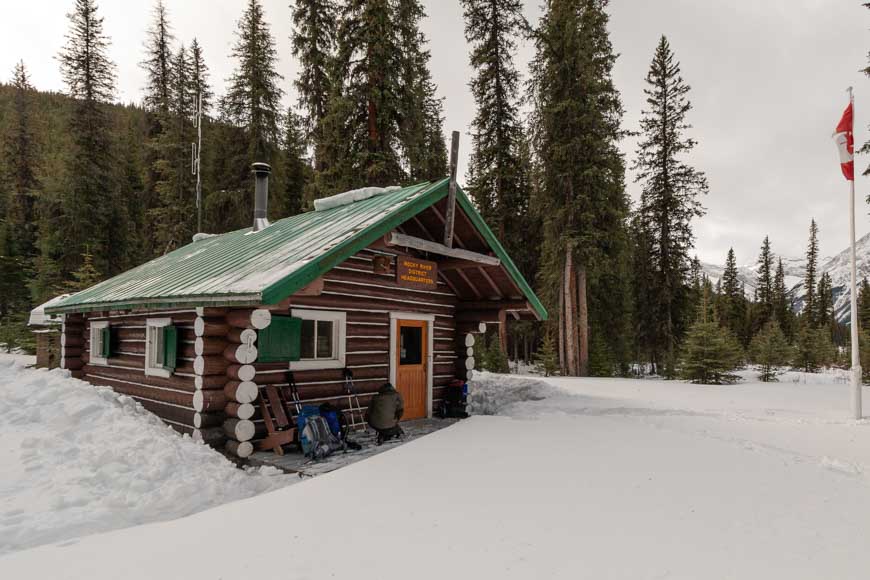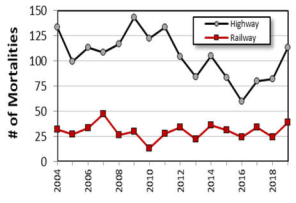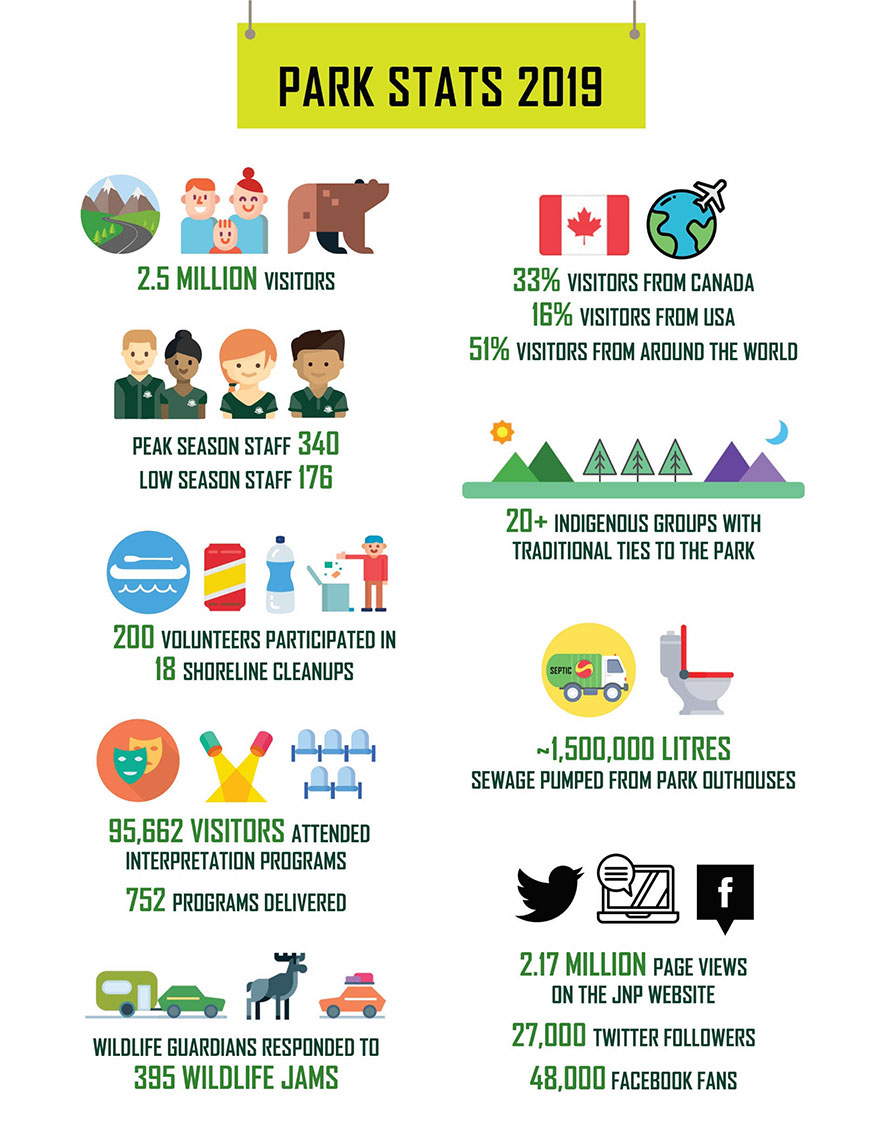
2019 Annual Report
Jasper National Park

On behalf of the people of Canada, Parks Canada protects and presents nationally significant examples of Canada's natural and cultural heritage, and fosters public understanding, appreciation and enjoyment in ways that ensure the ecological and commemorative integrity of these places for present and future generations.
Parks Canada is pleased to present highlights of our work in Jasper National Park for 2019 and to provide an update on implementing the Jasper National Park Management Plan.
Download the 2019 Annual Report (PDF 1.7 MB)
Table of contents
- Welcoming visitors to mountains of opportunity
- Celebrating history, culture and the World Heritage Site
- Bringing mountains to people where they live
- Ensuring Healthy Ecosystems
- Strengthening relationships with Indigenous peoples
- Fostering open management and innovation
- Managing growth and development
- Park Stats 2019
Welcoming visitors to mountains of opportunity
Visitor statistics
We welcomed 2.5 million visitors to Jasper National Park in 2019. 33% came from Canada, 16% from the United States, and 51% from elsewhere around the world. We welcomed more than 420,600 frontcountry campers and more than 27,800 backcountry campers in 2019.
Human wildlife co-existence

Photo: Parks Canada / M. Bradley
Parks Canada supports positive wildlife viewing experiences, while working actively to reduce the frequency and severity of negative encounters between people and wildlife, through innovative management practices.
In 2019, Human Wildlife Conflict staff responded to 3,628 incidents, of which 300 had human safety concerns.
The Jasper National Park Wildlife Guardians managed 395 wildlife traffic jams in 2019. This is the highest number of ‘wildlife jams’ on record in the park.
The increase in wildlife traffic jams and human-wildlife conflict incidents along roadways pose safety risks for both wildlife and visitors. New initiatives to address these concerns include:
- a new message toolkit
- a ‘stay in your vehicle’ campaign
- no-stopping zones
- working with Tourism Jasper on training, messaging and videos for the tourism industry
Picnic patrol
A prevention team known as the ‘Picnic Patrol’ launched in 2019 to educate visitors about illegal camping, alcohol use and smoking at day use areas, restrictions for dogs at beaches, proper containment of wildlife attractants, and other wildlife issues. The team addressed 5,438 incidents from May through September.
Visitor safety team

Photo: Parks Canada / C. Roy
The Jasper Visitor Safety team is responsible for lost person searches, emergency backcountry medical services and traumatic injury rescues in the park. In 2019, the team responded to 174 incidents.
The team monitors and manages 76 avalanche paths that impact Highway 93 North and the Maligne Lake Road. In 2019, the team carried out highway avalanche control seven times which closed the Parkway for 19 days. They used a total of 4200 kg of explosives, to create avalanches ranging from size 1 (relatively harmless) up to size 4 (capable of destroying rail cars, buildings, and large areas of mature forest).
Infrastructure investment
Parks Canada continued work in 2019 on the multi-year $3 billion Federal Infrastructure Initiative. Approximately $312 million has been allocated from 2015 to 2022 to rehabilitate roads, highways, visitor facilities and critical infrastructure in Jasper National Park.
Mount Edith Cavell day use area
The Mount Edith Cavell Road and Day Use Area were reopened in 2019, following reconstruction to address damage from flood events in 2012 and 2014. Parks Canada rerouted access to the day use area, expanded the parking lot, added new washrooms and resurfaced part of the Path of the Glacier Trail.
Completed park roadway projects
- Highway 16 at Jasper Lake was widened to provide safe access for visitors with new turning lanes and a parking area.
- Passing lanes were constructed on Highway 16 near the Jasper airstrip.
- West of the town of Jasper, sightlines were cleared, rocks scaled, and netting was placed in two places to test its ability to deflect rocks from the roadway.
Whistlers Campground
Construction work is underway at Whistlers Campground, Parks Canada’s largest campground. Whistlers Campground was built in the 1960s and has not had any significant upgrades since that time. This project is the most significant investment in visitor facilities in Jasper National Park in the past 50 years. The new Whistlers Campground will open in May 2021 and will have modernized infrastructure, high-quality visitor services and a vibrant visitor offer that will enable Jasper National Park to host travelers for the next 50 years.
Snaring Overflow Campground
Snaring Overflow Campground opened this year with regraded roads, better defined and levelled campsites and additional facilities for visitor comfort.
Jacques Lake cabin

Photo: Parks Canada / R. Gruys
Parks Canada and the Alpine Club of Canada entered into a trial agreement for the winter operation of the Jacques Lake Patrol Cabin. The cabin offers visitors rustic winter backcountry accommodation at the end of an intermediate level trail.
Trails and backcountry camping
Water ruled the trails this season. Heavy rainfall kept crews busy replacing bridges and addressing rock slides and water surges on a number of trails. Other projects included:
- Pyramid Bench: joining forces with the Jasper Trails Alliance to clean and re-open trails after the firebreak clearing.
- Lower Fryatt Campground: upgrades to create a better novice backcountry experience.
- Overlander Trail: repairing the tread and a bridge.
- Maligne Lake: new signage at all campgrounds and picnic areas. New Moose Lake Trail tread to create easier access for trail users.
- Brazeau: nine crossings were replaced.
- Tonquin Valley: treads, campgrounds and boardwalks replaced along Amethyst Lake and Portal side of trail.
- Skyline: new campground and trail signs installed.
Whistlers Summit Trail restoration
The Whistlers Summit Trail restoration project continued in collaboration with the Friends of Jasper National Park and the Jasper SkyTram. Improvements are intended to protect and restore the fragile alpine environment.
Interpretation

Photo: Parks Canada / L. Carter
In 2019, 95,662 visitors attended 752 interpretation programs. Program topics included species at risk, mountain pine beetle, wildlife and Indigenous culture.
Congratulations to the Jasper National Park interpreters! They received the Interpretation Canada Gold Award of Excellence for Bats in the Dark. Spencer Dunn and Marie-Hélène Hamel wrote and produced this great theatre program.
Education programs
The Palisades Education team delivered programs to more than 2116 students from 96 different groups at the Palisades Stewardship Education Centre and 45 programs to 958 students at the Marmot Learning Centre. The Palisades Centre and Marmot Learning Centre programs are possible through a long-established partnership with Grande Yellowhead Public School Division and Ski Marmot Basin.
Park volunteers

Photo: Parks Canada, K. Gedling
Friends of Jasper National Park contributed 6,350 volunteer hours in 2019, through initiatives including Trail Tuesdays, Whistlers Wednesdays and Parks Day. Additional park volunteers contributed 2700 hours in 2019. Parks Canada trained 55 volunteer trail stewards who supported responsible trail use and provided trail information to update the park’s public trail report.
Shoreline Cleanups
More than 200 volunteers participated in 18 shoreline cleanups. Shoreline Cleanups help us meet objectives in the new Jasper National Park Shoreline Action Plan to restore lakes and rivers and their shoreline habitat. In 2020, we will be reminding boat owners to remove any boats they have stored on lakeshores.
Overall park visitation and campground use
Overall park visitation increased over 2018 levels. There was a drop in total camping nights as Whistlers Campground was closed for reconstruction in 2019.
| 2015 | 2016 | 2017 | 2018 | 2019 | |
|---|---|---|---|---|---|
| Attendance | 2,258,830 | 2,354,809 | 2,425,218 | 2,434,665 | 2,466,485 |
| 2015 | 2016 | 2017 | 2018 | 2019 | |
|---|---|---|---|---|---|
| Camping | 166,381 | 176,735 | 199,550 | 193,625 | 140,212 |
Celebrating history, culture and the World Heritage Site
Ice patch archaeology
This year, our ice patch archaeology work expanded to new areas near Glacier Pass, at the north end of the park. The Archaeological Survey of Alberta, and the Royal Alberta Museum, collaborated with Parks Canada to further examine the history of the area through ice core samples.
Did you know?
Parks Canada has been working closely with local Indigenous partners to create a large, permanent exhibit that is expected to open in 2021. The exhibit will consist of interpretive panels and a central plaza to be constructed in the green space adjacent to the Information Centre in Athabasca Park.Bringing mountains to people where they live
Outreach and promotions
In 2019 we reached more than 13,000 people, at events and outreach programs in Edmonton and Calgary to educate about caribou conservation and species at risk.
Parks Canada collaborated with Alberta Parks to host our feature exhibit on whitebark pine, fire and caribou at Peter Lougheed Provincial Park and at the Fish Creek Environmental Learning Centre in Calgary where it reached 30,000 people.

Photo: BBC
Greta Thunberg documentary
Parks Canada welcomed the young climate champion Greta Thunberg and her dad to Jasper National Park in October 2019 to learn about whitebark pine and Jasper’s alpine ecosystem. Greta's visit will be featured in a BBC documentary series that followed her on her journey across North America. The documentary will raise awareness of Jasper National Park’s mountain ecosystem with youth around the world.
Ensuring healthy ecosystems
Southern mountain caribou

Photo: Parks Canada
Caribou herd numbers in the park are stable, but very low. The Tonquin herd has about 31 animals, and the Brazeau herd has 10 animals or less. These herds are too small to recover on their own.
It is not likely that caribou remain in the Maligne Valley. Three aerial surveys in 2018 and 2019 failed to locate caribou tracks or animals.
The À La Pêche herd spends time in and outside of the park in the north boundary area and has about 150 individuals.
Wolf density is low, indicating that conditions for caribou survival and recovery are improving. We continue to monitor ecological conditions in caribou habitat for all four herds.
We are investigating several options to increase the small caribou herds in the park and are exploring the feasibility of a conservation breeding program.
Whitebark pine conservation
The whitebark pine is an endangered species vital to the health of the alpine ecosystem. It is impacted by white pine blister rust (an invasive species), mountain pine beetle, historic fire suppression and climate change. This past year, 3800 two-year old seedlings were planted.
Jasper National Park continues to partner with tentree, a Canadian clothing company that plants ten trees for every product sold.
Through this partnership, tentree contributes to the cost of whitebark pine seedlings, and communicates conservation and restoration messages to its audience of 1.8 million social media followers.

Highway/railway wildlife mortality
Unfortunately, in 2019, 113 animals were killed on park highways, and 39 were killed on the railway. We work with partners to minimize the number of animals killed, by enforcing vehicle speed limits, and by reducing attractants that draw wildlife close to roads and the railway. We also remove road- and rail-killed animal carcasses quickly so that they do not become a public safety concern or attract predators.
Wildfire risk reduction work

Photo: Parks Canada / M. Bradley
In 2019, Parks Canada reduced the amount of forest fuels in 310 hectares of mountain pine beetle affected forest west of the town of Jasper. This work enhanced the Pyramid Bench community fireguard, constructed in the 1980s, and reduces wildfire risk to the townsite. It will also allow for the use of more effective prescribed fires west of the community. An additional 60 hectares of mountain pine beetle killed pine trees were removed from Whistlers Campground, further helping reduce wildfire risk south of the Jasper townsite.
Parks Canada and the Municipality of Jasper are active partners in the “FireSmart” community protection program. In 2019, forested areas around the edge of town were thinned to reduce forest fuels near people and property, and to keep exit and access routes clear and safe for travel in the event of an emergency.
Mountain pine beetle management
The winter of 2018-19 brought a six-week period of extreme cold temperatures to Jasper National Park. Population sampling in 2019 by the Canadian Forest Service estimated 98 percent of mountain pine beetle larvae were killed in the winter of 2019.
Townsite bear attractants
Parks Canada provided free removal of fruit trees to Jasper town residents to reduce bear attractants. When bears get an easy meal from fruit trees or bird feeders in town, they quickly learn to come back for food. As they become more habituated, the chance of negative encounters with humans increases.
Unfortunately in 2019, Parks Canada was forced to kill two bears who were habituated to feeding from fruit trees and bird feeders in town. It is important that residents eliminate bear attractants to protect bears and the public.
Strengthening relationships with Indigenous peoples
Jasper Indigenous Forum
Twice a year, the Jasper Indigenous Forum brings together park managers and over 20 Indigenous groups with historical connections to the park, to discuss park management and operational issues. Jasper Indigenous Forum members also form a number of working and advisory groups that meet more frequently and provide guidance to Parks Canada on a variety of projects. Two working group projects from 2019 are profiled below.
Indigenous Awareness Training

In collaboration with a working group of the Jasper Indigenous Forum, Parks Canada piloted an Indigenous Education and Awareness program for park staff. Local Indigenous partners taught staff about Indigenous history and connections to the park, offered insights into cultural knowledge and practices, and discussed approaches to supporting Indigenous reconnection to the park.
Indigenous Guardian Pilot Program
In July 2019, nine local Indigenous partners came to the park as Indigenous Guardians to work alongside, learn from and share knowledge with Parks Canada staff. The participants shared that the Guardian Pilot Program reconnected them to the lands in their traditional territories and has been an important step in the process of reconciliation.
Fostering open management and innovation
Financial Summary
In fiscal year 2018-19, the Jasper Field Unit (which includes Fort St. James National Historic Site in British Columbia), had a budget of $33 million. The budget is derived from revenue from entry fees, campground fees, and land rents, as well as Parks Canada funding for both a housing initiative and re-development of Snaring Campground.
In 2019, 48% of the budget was allocated to staff salaries, 19% to operating costs, and 33% to capital investments.
Additionally, the field unit received approximately $32 million in special funding for projects related to wildfire management, conservation and restoration, and investment in assets, including trails, campgrounds, roads and bridges.
Did you know?
Jasper Voted Amongst North America’s Best Ski Towns
For the second year in a row, Jasper has made it to the top three in USA Today “Best Ski Towns in North America”. Jasper is credited as offering a ‘decidedly laid-back and unpretentious base for winter adventure’. Jasper is the only Canadian town to make the list.
Managing growth and development
Municipal Development
In 2019 Parks Canada issued a total of 188 development permits and 40 building permits in the Town of Jasper for projects from new fences, to new homes and businesses.
| Commercial Floor Area (CFA) Cap 2001 |
9,290 m2 | % of total |
|---|---|---|
| Developed CFA | 4,560 m2 | 49% |
| CFA not developed, but allocated | 3,355 m2 | 36% |
| C1/C2/C3/C4 CFA available for allocation | 1,374 m2 | 15% |
| S Block CFA available for allocation | 0 m2 | 0% |
Land Use Open House
Parks Canada is reviewing several regulations under the Canada National Parks Act, including the Town of Jasper Zoning Regulations, with the goal of modernizing our approach to planning and land use. In March 2019, Parks Canada hosted an open house to present information and seek input from the public on land use issues. A ‘What We Heard’ Report is available.
Hostelling International

Photo: HI Canada
A new, centrally-located hostel opened its doors in the town of Jasper in 2019. The new facility provides 157 beds for travelers, and short-term accommodations for new residents. It replaces Whistlers Hostel, which is now closed and will be decommissioned.
ATCO Electric Transmission Line
ATCO Electric completed the construction of a 45 km power line connecting the Jasper townsite to the provincial electrical system. The new power line was energized on May 11, 2019, eliminating the need for isolated power generation at the Palisades Power Plant.
ATCO Electric began the clean-up phase of the project in summer 2019 and is following up with restoration and monitoring commitments.
Management Planning
All the mountain national parks (Jasper, Banff, Kootenay, Yoho, Waterton Lakes, Mount Revelstoke and Glacier) are working on new draft park management plans. The management plans will set out the future direction for each park, including a vision, key strategies and objectives for the next 10 years.
In 2019 Indigenous peoples, stakeholders and the public participated in the management planning process through online surveys, public meetings and workshops, and small-group meetings. A ‘What We Heard’ Report is available.

Infographic - Text version
Park Stats 2019
- 2.5 Million visitors
- Peak season staff 340; Low season staff 176
- 200 volunteers participated in 18 shoreline cleanups
- 95,662 visitors attended interpretation programs; 752 programs delivered
- Wildlife Guardians responded to 395 wildlife jams
- 33% visitors from Canada; 16% visitors from USA; 51% visitors from around the word
- 20+ indigenous groups with traditional ties to the park
- ~1,500,000 litres sewage pumped from park outhouses
- 2.17 Million page views on the JNP website; 27,000 Twitter followers; 48,000 Facebook fans
- Date modified :